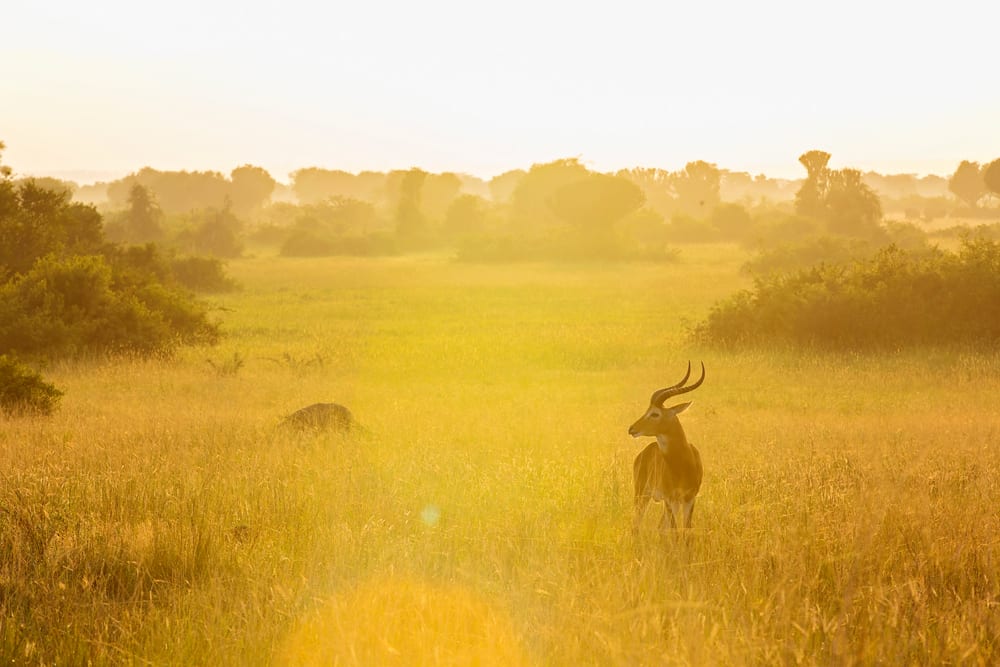
Dec 9-15
I’m sitting here on morning number three of our time in Queen Elizabeth National Park, enjoying the breeze off the Kazinga Channel, watching the buffalo and duelling hippos across the channel, and nursing pot after pot of ginger tea, which is strong enough to cure what ails me and possibly strip wallpaper at the same time, while the boys enjoy a morning drive. The weather is gorgeous and I’m enjoying being outdoors before the overwhelming strength of the equatorial sun kicks in and drives me into the shade.
On my way to the restaurant this morning, I walked with Bibian, who was on her way to work at the restaurant. When I commented that there were a lot of animals around last night, she told me she had just met an elephant in the trees when she was leaving the village (the village is about 100m behind our cabin) and then she looked at the buffalo sitting under the tree right by our cabin and said, “Oh, those are loser buffalo.” When I repeated this back to her to make sure I’d heard right, she said that they’d been driven out of their herd, “So they are losers.” That’s one way of phrasing it…
Leaving Kabale in the morning on the 9th, three things about Alex quickly became apparent: he is very “over” Africa, and most certainly Africans; he doesn’t really run on a schedule (although he’s never particularly late, he seems to have a habit of saying, “Oh, we are leaving now?” when we’re loading the car at the time we said we would); and he can talk more than anyone I’ve ever met. For real. I think he’s been saving up every single thought for the past four months that he’s been travelling and they’re all spilling out in one continuous stream this week. This guy brings out the most random 70s and 80s movie references, thinks he does a stellar Columbo impersonation, and has a tendency to be unable to maintain silence for more than two minutes at a stretch. If it weren’t for the fact that he is so well-intentioned, I’d have put earplugs in by hour 2. I was quite happy to have given up the front seat to him, not only because I then ended up feeling like a queen in the spacious back seat area, but also because it meant that he could talk crap with Rich, who has the impressive ability of being able to talk – or, in this case, listen to – crap with anyone.
Our drive to Fort Portal was surprisingly easy, given that Rich had read a hilarious account of what Ugandan roads and driving were like prior to our departure. We were expecting massive potholes, reckless driving, and the potential for banditry (be glad for the lack of reliable internet so that I couldn’t spill the beans on that last part, Mom :P). Maybe because we’d been baptised into the world of horrific driving conditions while we were in Laos, we were disappointed on all counts.
Fort Portal was impressive at first glance, since we went straight for lunch at Gardens Restaurant, which looks out onto the main road and Tooro Palace. On second glance, it’s a bit less appealing. There is very little in the way of budget accommodation, and most of what was there bore striking resemblances to crack dens – not welcoming places to spend the night. We settled at Rwenzori Travellers Inn, which ended up being a friendly, least-like-a-crack-den place to spend a couple of nights.
In the morning, we packed up and drove out to Kibale Forest National Park, whose claim to fame is being home to the highest density of primates in the world. Although it has the same number of species as Rwanda’s Nyungwe Forest NP, it occupies a much smaller tract of land. Chimpanzee tracking is incredibly expensive here ($150), so our plan was to go for a nature walk, which would be a third of the price. When we got there, we learned that our info was, once again, very outdated, and the price had gone up enough that we all decided not to bother.
Feeling slightly disappointed and rather shocked at the price, we climbed into the van and headed for the Crater Lakes. This little region in southern Uganda is home to five or six almost perfectly round mountain lakes. We paid the somewhat ludicrous price of $20 each (again, our info was very outdated and they’d increased the price tenfold in three years) and spent the next 2.5 hours with Elizabeth, a wonderfully gentle local woman who led us through a local village and out into the forest around the lakes. We spotted the local “humble” hippo (so-called because he has been there for 15 years and has never attacked anyone) out in the water of the second lake, and then we climbed the hills up to the “Top of the World”, which is a scenic lookout just below the actual hilltop, where the local treasure, an Australian named Dave, has built a house.
Back at the rather over-priced CVK Guesthouse where our trek began, we spent a few minutes washing the dirt from our legs and watching some more vervet monkeys, before climbing back into the van and heading back to Fort Portal. Our plans to stay in Kibale and near the Crate Lakes were both foiled by over-priced accommodation, so we ended up back at Rwenzori Travellers Inn for our second night, a full day ahead of schedule. The major bonus: I got my first uncomplicated hot shower since Joburg and I couldn’t have been happier about it. :)
In the morning, we packed up – again – and headed south to Queen Elizabeth National Park, which is Uganda’s most popular safari option. There was some slight worry that we’d run into trouble booking rooms or getting permits for the park or chimp tracking because there’s very little info available to those who aren’t starting their journey in Kampala. However, we were relieved to learn that, other than a bit of backtracking to get to the correct gate, our plan was going to work out. We paid a measly $12 to bring the van into the park, and each paid for chimpanzee tracking and three days of park access. We also found out that the “dorms” are actually twin rooms and were only going to cost us $8 each. Bargain! We ended up staying at Mweya’s Lower Camp for four nights and thought that the combination of simple-but-cheap accommodation and a restaurant with good food made for a pretty great deal. It helps that we befriended Bibian, who was our server every day and looked after us like a mother.
The tracks in the park are a bit of a confusing mess of seasonal diversions, actual trails, and messes of mud or hard-packed earth that used to be trails but are definitely no longer accessible – even the tracks on the map are sometimes so deeply rutted that our van has struggled to get through. We’ve hit a few dead ends and had several tense moments where we weren’t too sure that Rich was going to be able to manoeuvre the van out of whatever mess we were in at the time, but he’s managed to maintain an impressive track record thus far.
The park is relatively small and lacks the variety of game found in other parks weve been to. Unlike the Kruger, there are no zebra, giraffe, impala/gazelles/springbok, rhino, or, thankfully, baboons (although there are baboons in some parts of the park, there are none along the Mweya Peninsula where we were based). However, there are plenty of elephant, buffalo, hippos, fish eagles, storks, Ugandan kob, topi, bushbuck, Defassa’s waterbuck, warthog, banded mongoose, about 50 leopards and enough lions to keep us entertained.
In our four days here, we managed to cover most of the permanent tracks in Mweya, Kasenyi, and ventured to Ishasha with a guide, which is something I’d strongly recommend to anyone considering this trip, since getting lost on the myriad tracks down there is almost a sure-thing. Some favourite sightings:
- a buffalo so newly born that it was still wet and struggling to walk to its mother
- the tiniest elephant I’ve seen, scrambling across the road just behind its mother and then scurrying around in the bush
- a heard of 200+ buffalo making their way in a great, meandering zigzag across the savannah
- six lions settling in to enjoy a fresh buffalo kill (so fresh that, when we found them, they hadn’t yet started eating)
- catching a kob first thing in the morning as its roan hide and all of the savannah grass around it was lit to a brilliant gold
- massive herds of 300+ kob grazing in the savannah with the Rwenzori mountains, usually hidden amongst the clouds, finally visible behind them
- the waterbuck, warthogs, buffalo, elephant and hippos that have all been outside our cabin at various points during our stay
- two fish eagles entwining in a mid-air courtship ritual and then plummeting into the lake below
- a flash across the road, finishing in a dark-brown-and-white ringed tail that told us we’d spotted a genet (a small member of the cat family)
- a fig tree containing three very sleepy, very contented lions in Ishasha
As we prepare to leave the park, I’m struck by the vast differences between my own reality and that of the folks who live in this area. Supper is often just matooke (mashed plantain) or “boiled Irish” (as in the potatoes); birthday parties are cause for donning your finery and spending the evening at the camp restaurant; grass is cleared using a sort of primitive machete-scythe and lots of elbow grease; things that go bump in the night are actually things that bump, snarl, grunt, and snort in the night. Stories like Bibian’s, where villagers are confronted by animals including lion and leopard, are just part of life for those who live here and instead of fearing it (like Rich and I do, particularly at times like last night when we were both startled out of our sleep by a horrible shrieking sound not too far from our cabins), they believe that a healthy, respectful relationship with the animals in the park keeps them safe. When attacks do happen, such as the five year old who was attacked by a leopard two months ago and is still recovering in the hospital, they see that, too, as part of life.
Up next: details of our chimp tracking experience (for you); back to Kabale and on to Lake Bunyoni for four days of lakeshore rest (for us)
Grateful for: hot showers (!); ginger tea












